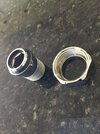Hello Folks,
I am in the process of swapping out an old chrome curved towel rail for a new taller one. I will use the existing valves. There is absolutely no vertical play in the pipe (as the microbore pipework is buried in a solid wall) making it difficult to attach the chrome towel radiator to the valves.
I'm pretty sure that the existing tails are 3/4" x 1/2" union radiator valve tails. I won't be able to get the new towel radiator to attach to the valves as once the radiator is hung, I won't be able lift the valves upward a few millimetres to screw on the union nut as there's no vertical pipe movement.
I noticed that the previous homeowner got round this problem (ingenious or foolish?) by slackening off the screws (just a little) where the four wall clamps attach to the wall. In doing so he was able to wobble all four clamps up and down a few millimeters so he could hang the radiator and drop it onto the valves and tighten up the 3/4" nut.
Is an extension piece the only way to solve the problem of bridging the gap that exists (when the rad is hung) between the valves and the 3/4" nut?
E.g.
https://www.bes.co.uk/adjustable-radiator-extension-piece-to-40mm-7511/
I am in the process of swapping out an old chrome curved towel rail for a new taller one. I will use the existing valves. There is absolutely no vertical play in the pipe (as the microbore pipework is buried in a solid wall) making it difficult to attach the chrome towel radiator to the valves.
I'm pretty sure that the existing tails are 3/4" x 1/2" union radiator valve tails. I won't be able to get the new towel radiator to attach to the valves as once the radiator is hung, I won't be able lift the valves upward a few millimetres to screw on the union nut as there's no vertical pipe movement.
I noticed that the previous homeowner got round this problem (ingenious or foolish?) by slackening off the screws (just a little) where the four wall clamps attach to the wall. In doing so he was able to wobble all four clamps up and down a few millimeters so he could hang the radiator and drop it onto the valves and tighten up the 3/4" nut.
Is an extension piece the only way to solve the problem of bridging the gap that exists (when the rad is hung) between the valves and the 3/4" nut?
E.g.
https://www.bes.co.uk/adjustable-radiator-extension-piece-to-40mm-7511/





